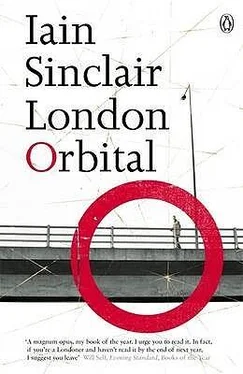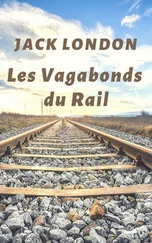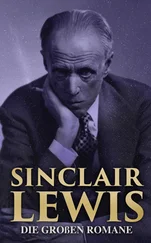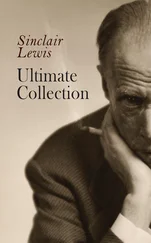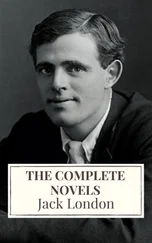Iain Sinclair
London Orbital
Iain Sinclair is the author of Downriver (winner of the James Tait Black Memorial Prize and the Encore Award); Landor’s Tower; White Chappell, Scarlet Tracings; Lights Out for the Territory; Lud Heat; Rodinsky’s Room (with Rachel Lichtenstein); Radon Daughters; and London Orbital . He lives in Hackney, East London.
For Renchi, and for Kevin Jackson,
shadows on the road
… for tho’ eclipses of thought are to me a living inhumement and equal to the dread throes of suffocation, turning the valley of vision into a fen of scorpions and stripes and agonies, yet I protest, and glory in it for the sake of its evidence, of the strength of spirit that when inspir’d for art I am quite insensible to cold, hunger and bodily fatigue…
Samuel Palmer (letter to George Richmond)
K. Hodges (London, W8): What was your worst moment on TV?
Jeremy Paxman: Interviewing a man under the impression that he was a schizophrenic in care in the community when in fact he was an engineer who’d come on to talk about the M25.
Independent (29 September 1999)
It started with the Dome, the Millennium Dome. An urge to walk away from the Teflon meteorite on Bugsby’s Marshes. A white thing had been dropped in the mud of the Greenwich peninsula. The ripples had to stop somewhere. The city turned inside-out. Rubbish blown against the perimeter fence. A journey, a provocation. An escape. Keep moving, I told myself, until you hit tarmac, the outer circle. The point where London loses it, gives up its ghosts.
I have to admit: I was developing an unhealthy obsession with the M25, London’s orbital motorway. The dull silvertop that acts as a prophylactic between driver and landscape. Was this grim necklace, opened by Margaret Thatcher on 29 October 1986, the true perimeter fence? Did this conceptual ha-ha mark the boundary of whatever could be called London? Or was it a tourniquet, sponsored by the Department of Transport and the Highways Agency, to choke the living breath from the metropolis?
Thatcher, who never grasped the concept of ‘dressing down’, her range going from airfixed-in-pressurised-dimethyl-ether (with solvent abuse warning on can) to carved-out-of-funerary-basalt, decided that day, or had it put to her by style consultants, that she should treat this gig as an outside broadcast, a chat from the paddock at Cheltenham, not the full Ascot furbelow. A suit, semi-formal (like Westminster Cathedral), in a sort of Aquascutum beige.
Autumn. No hat. A war footing: mufti-awkward. Argie bashing, ranting. Cromwell-fierce, hormonally stoked, she wields her small scythe, dismissing the unseen enemy, stalkers in the bushes, eco-bandits, twitchers, pennypinchers, lilylivered Liberal fifth-columnists, bedwetters, nay-sayers.
‘I can’t stand those who carp and criticise when they ought to be congratulating Britain on a magnificent achievement and beating the drum for Britain all over the world.’ Rejoice. The military/industrial two-step. That old standard. Mrs Thatcher went on to rave over ‘the Sainsbury’s effect’, the introduction of US mall-viruses, landscape consumerism, retail landfill.
YES was the word. Thatcher filtered in a perpetual green glow, like a Hammer Films spook. Bride of Dracula. Green meant GO. This business with ring roads had been floating around the ministries since the Thirties, since they’d noticed that cars were taking over the planet. At first, the idea had been: car as servant, parkways, elevated heaven ramps (Michael Powell’s A Matter of Life and Death ). Road-ribbons between lakes and golf courses. Orbital grooves that interconnected, working their way out from a loop around the royal bits (palaces, parliaments) to the inner suburbs, Hampstead and Holland Park. To the outer suburbs, unknowable Stanmore, Totteridge, Ponders End. To green belt nothingness, the great nowhere at the edge of Epping Forest; a territory defined by the red Italianate water towers of Victorian and Edwardian madhouses. And why stop there? Why not opt for abandoning airports and retaining huge runways that roared past Oxford, Cambridge, Winchester and Canterbury?
The snipping of the ribbon in October 1986 prefigured other ribbons, blue and white bunting that would turn the inner cities into a necrophile carnival: the spite-karma of terrorist outrages, turf wars. Irishmen, on their way home from the pub, shot, colandered, by rapid response units, for the crime of carrying unlicensed table-legs.
Newsreel paranoia is such that in the back files, even at this distance, nothing more than a face is revealed. We may know who is cutting the ribbon, but not where. Time has been suspended. There were, from the start, M25 myths: the woman who thought it was an oversized roundabout, the family who decided to keep going until they saw the sign for Newcastle. Archive footage doesn’t let on: the location where Margaret Scissorhands, amputator of naughty thumbs, did the deed is still a secret. It wasn’t at the official starting point, Junction 1, south of the Queen Elizabeth II Bridge, near Dartford. Nor was it within range of the Esso storage tanks at Purfleet, the soapy perfume of Procter and Gamble’s West Thurrock factory. Nor out in the deadlands, where the blue highway loses its nerve and turns yellow for the elevated Thames crossing. A hawk-eyed swoop at the cameras on the remote north-west frontier, not too far from South Mimms service station. So it was rumoured.
A television researcher with superhuman determination, a man called John Sergeant, spent weeks on the road, living in a rented scarlet Mondeo, checking co-ordinates, chasing whispers. He narrowed the area down to a section of straight road, somewhere between Potters Bar and Junction 21 (the Ml interchange). He would interrogate newsreel clips, freeze frame, photograph the monitor; return to the motorway. Compare and contrast. He worked the hard shoulder. He scanned soft estates. He came close, but he couldn’t pin it down with absolute precision.
That was left to Tony Sangwine of the Highways Agency. The film-essayist Chris Petit and I spent a morning on the road with Sangwine. The man was a visionary, a landscaper and motorway horticulturalist. He realised that taking on the orbital loop was the contemporary equivalent of getting a Capability Brown commission. Motorways were the last great public parks. Sangwine knew every weed, every salt-resistant clump of grass. He spoke lovingly of roe deer and short-tailed voles. The Highways Agency had planted more broadleaf woodland around the M25 than anywhere else in England. ‘We have introduced the woodland flora you associate with ancient, semi-natural woodlands,’ Sangwine boasted. ‘Bluebells, dog mercury.’
Sangwine was there for the opening party, the marquee on an old airfield, the lunch that Thatcher didn’t attend. She arrived in a bullet-proof car with security outriders. She snipped the ribbon and vanished. Sangwine pointed out the exact spot, an emergency phone kiosk on the northside hard shoulder, close to where the River Colne flows under the motorway, close to the padlocked shell of Napsbury Hospital.
The opening of the road was a moment of tremendous occult significance; within minutes the first circumnavigators were on the move. Simon Calder, one of nature’s folding-bike men, travel editor of the Independent , had his thumb out. No fear of the snipper, the scissor-madame. He found the experience ‘dull’. No Kerouacian epiphany, no download of spiritual gain.
Читать дальше
